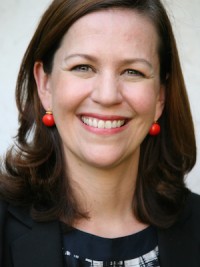Amy Whitaker, New York University – Rethinking Artists as Investors
 Should artists make more money for their work?
Should artists make more money for their work?
Amy Whitaker, Assistant Professor of Visual Arts Administration at New York University, describes a way artists can keep paychecks coming after their artwork has already been sold.
Amy Whitaker is a devoted teacher, mentor, and researcher at the intersections of art and business. At NYU, Amy teaches economics, finance, and entrepreneurship in the arts, and advises graduate students on thesis projects and start-ups. She worked previously for the Guggenheim, MoMA, and Tate, and for the investment firm D.E. Shaw & Co., L.P. and the artist Jenny Holzer. She has also worked on the internet law team at Harvard Law School and as an expert witness in copyright litigation. Her current research models what would happen if artists retained fractional equity in their work using blockchain technology.
Holding both an MFA and an MBA, Amy developed the business curricula for the New Museum Incubator (NEW INC) and for the Lower Manhattan Cultural Council. She has taught business to artists since 2003, when she gave a series of lunchtime talks to fellow painters at the Slade School of Fine Art. She has taught previously at Sotheby’s Institute, the School of Visual Arts, California College of the Arts, the Rhode Island School of Design, and Williams College. She is past president of the Professional Organization for Women in the Arts (powarts.org) and a former mentor to fellows of the TED Conferences. She has spoken widely including at the Aspen Ideas Festival, the Fast Company Innovation Festival, Google, the Warhol Museum, the Seattle Art Museum, the Barnes Collection, the Yale Club, the Princeton Club, Merck & Co., General Assembly, and TEDx. Her keynotes include RISD first year orientation and the Ontario Public School Board Association.
Amy is author of two books — Art Thinking (HarperCollins) and Museum Legs (Hol Art Books) — and co-author of The Social Life of Artistic Property (Publication Studio). She is at work on a new book, Economics of Visual Art, for Cambridge University Press. She has written for Fast Company, the Wall Street Journal, and e-flux, and her work has been covered in the New York Times, the Financial Times, Art Forum, the Art Newspaper, Artsy, Harpers, Forbes, the Boston Globe, Vanity Fair, and elsewhere.
Rethinking Artists as Investors
When an artwork is sold for the first time, an artist will typically consign the work to a dealer with the two parties splitting the proceeds fifty-fifty. For many artists, this is the only return they will ever see on their artwork, even if the work is later resold at auction for thousands more than the initial sale.
But what would happen if artists retained 10 percent equity in their artwork after the first sale? To answer this question, we analyzed the returns on retained equity for ten Robert Rauschenberg and nine Jasper Johns artworks using available auction data and private sales information. We then compared those returns to what the artists would have seen had they invested the dollar value of that 10 percent stake in the S&P 500 index. The artists’ retained equity portfolios outperformed the market by a factor of 2.8 to 986.8. For instance, a 10 percent equity stake in Rauschenberg’s work State—sold in 1959 for $300—would have become $44,000 in the art market. The same $30 investment in the S&P 500 would have returned $2,417 over the same time period.
The fractional equity model represents a structural change to how we view artists by positioning them as investors and allowing them to share in the value they help to create. The current market doesn’t account for initial investment and risk by the artist, including the cost of renting studios, buying paint etc. with no guarantee that someone will take interest. Rauschenberg’s and Johns’ success may not be typical of all artists, but the study shows the maximum possible return to the artist and therefore articulates why structural intervention in markets for creative work deserves serious consideration. The system can generalize the ways we compensate early stage creative work in any field, re-orientating the way we look at growth in the economy overall.


